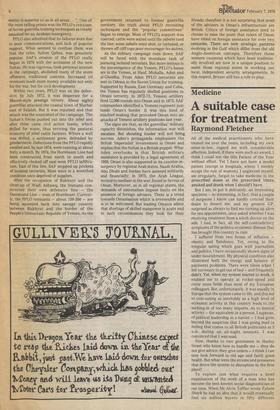Oman
A communist defeat
David Lynn Price
Altholigh in Europe and Africa the Soviet Union is trying harder than ever to increase its influence, elsewhere in the world its position is weaker. Its standing in the Middle East is novv less than that of the US; and in the Arabian peninsula, in particular, the Soviet Union faces defeat. What has happened is that a proxy war fought between the Soviet Union (which trains the guerrillas) and Britain (which advises the counter-insurgency forces) is coming to an end.
A few weeks ago, on December 11, 1975, the Oman government announced that the Sultan's Armed Forces (SAF), assisted by British officers, and supported by tribal irregulars and Iranian troops, had won a victory against the Popular Front for the Liberation of Oman (PFLO). It was not a sudden event, but the result of a careful, sustained threeLyear strategy in which civil development was as effective as militarY pressure". The final set-pieces of the campaign were fought in January and February 1975 as the Sultan's troops moved into western Dhofar. 'The valleys and caves in the jebel (high ground) around the guerrilla 'capital' of Rakhyut were scenes of bitter fighting with heavy casualties on both sides. But the end came when the SAF overran the headquarters of the PFLO's Ninth of June Regiment in the Wadi Ashawq.
Among the captured documents was an evaluation by PFLO's leadership — dated April 7 — of its political and military situation. In effect, it was an admission of defeat: "The present military position is in favour of the enemy from a sheerly Pic] military point of view. The
enemy is superior to us in all areas One of the most telling points was the PFLO's criticism of Soviet guerrilla training techniques as totally unsuited for an Arabian insurgency.
PFLO also admitted that its failures were due to poor communications, and lack of popular support. What seemed to confuse them was that the ruler, Sultan Qabus, was genuinely popular. SAF's erosion of the PFLO really began in 1970 with the accession of the new Sultan. He was vigorous, took personal interest in the campaign, abolished many of the more offensive, traditional customs. Increased oil revenues made more money available not only for the war, but for civil development.
Within two years. PFLO was on the defensive; by July 1972, it was desperate for a Maoist-style prestige victory. About eighty guerrillas attacked the coastal town of Marbat east of Salalah. But it was repulsed and that attack was the watershed of the campaign. The Sultan's forces pushed out into the jebel and after them came civil action teams, which drilled for water, thus reviving the pastoral economy of jebel cattle farmers. Where a well was drilled, a settlement grew, defended by gendarmerie. Defections from the PFLO rapidly swelled and, by late 1974, were running at about forty a month. By 1974, the Hornbeam Line had been constructed from north to south and effectively choked off east-west PFLO infiltration. East of this line, SAF mopped up pockets of isolated terrorists. Most were in a wretched condition once deprived of supplies.
After the occupation of Rakhuyt and the clean-up of Wadi Ashawq, the Iranians constructed their own defensive line — the Damavand Line — west of Hornbeam. Currently, the PFLO remnants — about 150-200 — are being squeezed back into savage country between Rakhyut and the border of the People's Democratic Republic of Yemen. As the government returned to former guerrilla territory, the truth about PFLO recruiting techniques and the "popular committees" began to emerge. Most of PFLO's support was coerced; cattle were seized until the jabalis toed the line; some jabalis were shot, or tortured, or thrown off cliff tops pour encourager les autres.
As the military campaign runs down, SAF will be faced with the mundane task of pursuing isolated terrorists. But more serious is the intransigence of the Yemen; PFLO's bases are in the Yemen, at Hauf, Mukalla, Aden and al-Gheidha. From Aden PFLO terrorists are sent to Odessa in the Soviet Union for training. Supported by Russia, East Germany and Cuba, the Yemen has regularly shelled positions in Omani terrority. In 1972-73, Yemeni artillery fired 12,000 rounds into Oman and in 1975, SAF commanders identified a Yemeni regiment just inside Oman's border. It was this kind of mischief-making that provoked Oman into air attacks of Yemeni artillery positions last year.
The signs are that, as the guerrillas' military capacity diminishes, the information war will escalate. But shouting louder will not bring success. Aden's propaganda emphasises the British 'imperialist' involvement in Oman and implies that the Sultan is a British puppet. Whai Aden overlooks is that British military assistance is provided by a legal agreement of 1958; Oman is also supported in its counter-insurgency by regional Arab states. Saudi Arabia, Abu Dhabi and Jordan have assisted militarily and financially; in 1975, the Arab League, invited to mediate in the war, found in favour of Oman. Moreover, as in all regional states, the demands of nationalism impose limits on the presence of foreign advisers. There is a trend towards Omanisation which is irreversible and is to be welcomed. But leading Omanis admit that shortage of skilled manpower is acute and in such circumstances they look for their friends; therefore it is not surprising that most of the advisers in Oman's infrastructure are British. Critics of foreign assistance tend to choose to miss the point that rulers of Oman have relied on foreign assistance for over two centuries. There are new strategic patterns evolving in the Gulf which differ from the old Anglo-American concepts. Therefore those western countries which have been traditionally involved are now in a unique position to assist those regional states in working out local, independent security arrangements. In this respect, Britain still has a role to play.



























 Previous page
Previous page